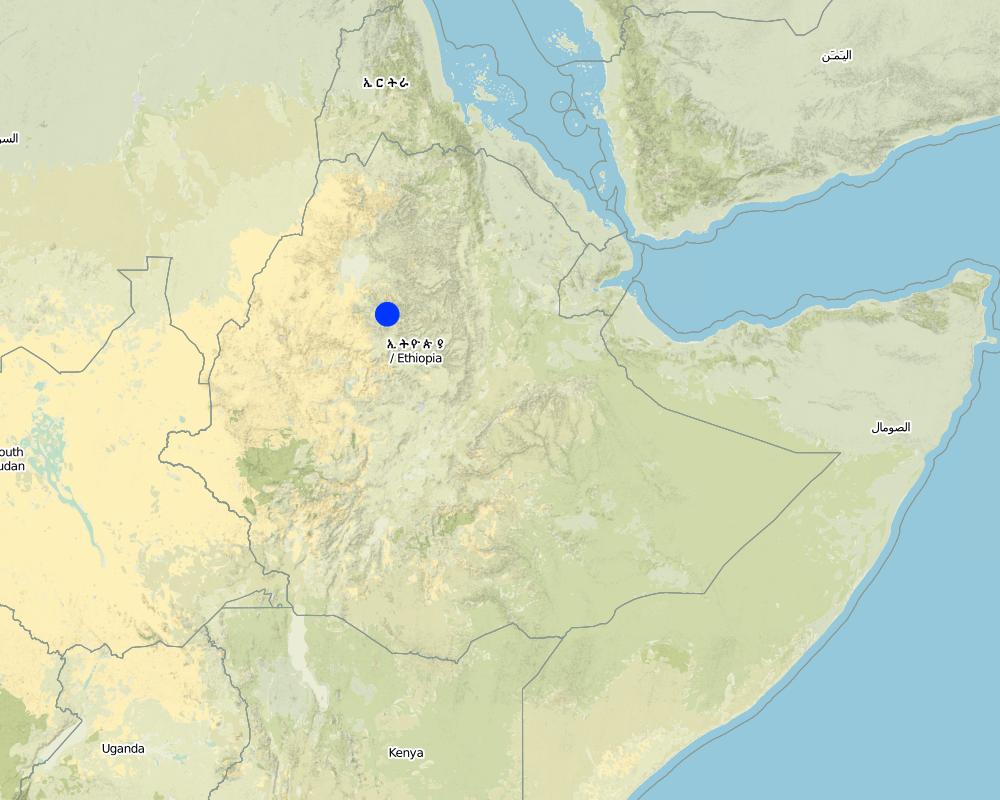Self help approach [埃塞俄比亚]
- 创建:
- 更新:
- 编制者: Philippe Zahner
- 编辑者: –
- 审查者: Fabian Ottiger
approaches_2377 - 埃塞俄比亚
查看章节
全部展开 全部收起1. 一般信息
1.2 参与方法评估和文件编制的资源人员和机构的联系方式
有助于对方法进行记录/评估的机构名称(如相关)
Swiss Agency for Development and Cooperation (DEZA / COSUDE / DDC / SDC) - 瑞士1.3 关于使用通过WOCAT记录的数据的条件
编制者和关键资源人员接受有关使用通过WOCAT记录数据的条件。:
是
2. SLM方法的描述
2.1 该方法的简要说明
Self help
2.2 该方法的详细说明
该方法的详细说明:
Aims / objectives: To develop his doing of activity by himself in order to manage his land., By consulting, Survey, Contain, bund for mation, embankment, Doing of terracing, Transporting of stones.
2.5 采用该方法的国家/地区/地点
国家:
埃塞俄比亚
区域/州/省:
Region 3
Map
×2.7 方法的类型
- 传统/本土
2.8 该方法的主要目的/目标
The Approach focused on SLM only
The objective of self help approach is only to motivate every one should have done in his own land than on others land.
The SLM Approach addressed the following problems: He couldn't do his duties of the right time due to so many causes.
2.9 推动或妨碍实施本办法所适用的技术的条件
法律框架(土地使用权、土地和水使用权)
- 启动
The existing land ownership, land use rights / water rights greatly helped the approach implementation: The land use right gives right and obligate to do his land properly, so it enhance self help approach.
- 阻碍
The low of implementing S.W.C. is not so much strong.
Treatment through the SLM Approach: Every one has perform his land at the right time and together.
3. 相关利益相关者的参与和角色
3.1 该方法涉及的利益相关者及其职责
- 当地土地使用者/当地社区
Working land users were work equally divided between men and women. The youngest household even he has no any wealth, he can manage his land by using his family labour.
- 国家政府(规划者、决策者)
- 国际组织
如果涉及多个利益相关者,请注明领导机构:
The SWC specialist and the land users together.
3.2 当地土地使用者/当地社区参与该方法的不同阶段
| 当地土地使用者/当地社区的参与 | 指定参与人员并描述活动 | |
|---|---|---|
| 启动/动机 | 被动 | Mainly:public meetings; partly: workshops/seminars; Training |
| 计划 | 互动 | Mainly: workshops/seminars; partly: public meetings; With watershed committees |
| 实施 | 自我动员 | Mainly: responsibility for minor steps; partly: casual labour; By using family labour for every activities. |
| 监测/评估 | 被动 | interviews/questionnaires, measurements/observations; |
| Research | 无 |
3.4 有关SLM技术选择的决策
具体说明谁有权决定选择要实施的技术:
- 仅限SLM专家
解释:
Decisions on the method of implementing the SLM Technology were made by mainly by SLM specialists with consultation of land users
4. 技术支持、能力建设和知识管理
4.1 能力建设/培训
是否为土地使用者/其他利益相关者提供培训?:
是
明确受训人员:
- 土地使用者
- planners (1), politicians/decision makers (2), extensionists/trainers (3)
4.2 咨询服务
土地使用者有权使用咨询服务吗?:
是
指明是否提供了咨询服务:
- 在土地使用者的土地上
说明/注释:
Name of method used for advisory service: PADETS; Key elements: Demonstration, Training system; 1) Advisory service was carried out through: government's existing extension system; Extension staff: mainly government employees 3) Target groups for extension: land users
Advisory service is inadequate to ensure the continuation of land conservation activities; The SWC activities left for some one else, no body, ensure sWC activities. The gov't do nothing for cont neuation of SWC wherever.
4.3 机构强化(组织发展)
是否通过这种方法建立或加强了机构?:
- 是,少许
具体说明机构的强化或建立程度:
- 本地
- by contributing labour
4.4 监测和评估
监测和评估是该方法的一部分吗?:
是
注释:
bio-physical aspects were ad hoc monitored through observations
technical aspects were regular monitored through observations
socio-cultural aspects were ad hoc monitored through observations
economic / production aspects were ad hoc monitored through measurements
area treated aspects were ad hoc monitored through measurements
no. of land users involved aspects were regular monitored hrough observations
management of Approach aspects were monitored through observations
There were no changes in the Approach as a result of monitoring and evaluation
4.5 研究
研究是该方法的一部分吗?
是
提供进一步的细节,并指出是谁做的研究:
Research was carried out on station
5. 融资和外部物质支持
5.1 该方法中SLM组成部分的年度预算
注释(例如主要的资助来源/主要捐助者):
Approach costs were met by the following donors: local community / land user(s) (For commarical work): 100.0%
5.2 为土地使用者提供财政/物质支援
土地使用者是否获得实施该技术的财政/物质支持?:
是
5.3 对特定投入的补贴(包括劳动力)
- 农业
| 具体说明哪些投入得到了补贴 | 程度如何 | 对补贴做出具体说明 |
|---|---|---|
| 种子 | 充分融资 | |
| 化肥 | 充分融资 | |
| Biocides | 充分融资 | |
如果土地使用者的劳动力是一项重要的投入,那么是不是:
- 自愿
5.4 信用
是否根据SLM活动的方法给予信用值?:
否
6. 影响分析和结论性陈述
6.1 方法的影响
该方法是否帮助土地使用者实施和维护SLM技术?:
- 否
- 是,很少
- 是,中等
- 是,支持力度很大
Because of the soil degradation improvement.
该方法是否改善了阻碍SLM技术实施的土地使用权/用户权问题?:
- 否
- 是,很少
- 是,中等
- 是,支持力度很大
The problem is likely to be overcome in the near future. If land use policy practiced
Did other land users / projects adopt the Approach?
- 否
- 是,很少
- 是,中等
- 是,支持力度很大
Every one has choosen/Adopt/self help activities than mobilization.
6.3 方法活动的可持续性
土地使用者能否维持通过该方法实施的措施(无外部支持的情况下)?:
- 是
6.4 该方法的长处/优点
| 土地使用者眼中的长处/优势/机会 |
|---|
| Motivate self help activities than mass mobilization (How to sustain/ enhance this strength: By giving training.) |
| 编制者或其他关键资源人员认为的长处/优势/机会 |
|---|
| It gives right to do on his land |
| One man do more in his own land than others land |
| The activiries have had quality wise |
6.5 该方法的弱点/缺点以及克服它们的方法
| 编制者或其他关键资源人员认为的弱点/缺点/风险 | 如何克服它们? |
|---|---|
| Starting time were delayed | Motivating & regulating to do so. |
| Making continious of SWC activities eg. Cut of drain on different pieces of land | By giving training and regulating the group activities. |
7. 参考和链接
7.1 方法/信息来源
- 实地考察、实地调查
- 与土地使用者的访谈
链接和模块
全部展开 全部收起链接
无链接
模块
无模块


